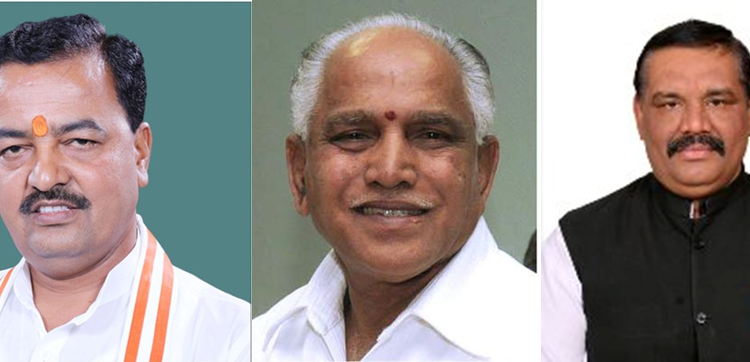UP, Punjab and Karnataka get New State Chiefs. The BJP’s prospects are looking good in the ongoing assembly elections. It looks as if they are all set to open their accounts in three states to which they have been largely alien. A fourth, Assam, is probably in the bag already. After consecutive debacles in Delhi and Bihar, the party seems on track to set its electoral arithmetic right again. In the next two years, the party will face three important assembly elections. They are looking to win at least two, if not all three of them. Party president Amit Shah has started setting the tone already.
Earlier this month, he announced new party state chiefs for each of the three states. Two of these states, Uttar Pradesh and Punjab, go to polls next year. Announcing new state chiefs one year in advance is ideal for the party. For one, the high command has made it clear to the state units that these will be the men leading them into the elections. Secondly, one year is the right amount of time for a new dispensation within a state unit to set their house in order, reinforce the cadre and organize a successful campaign. But Shah’s political acumen doesn’t end here. Considering the many nuances and intricacies of Indian politics, the choices Shah made are clever.
BJP’s New State Chiefs – Keshav Prasad Maurya the UP Chieftain
The elephant in the room is of course the assembly elections of Uttar Pradesh next year. Shah chose the 47 year-old Phulpur MP Keshav Prasad Maurya to lead the party. Mr. Maurya belongs to the Kushwaha community, which is backward and agrarian. This will help the BJP, which is strong among the upper caste population, to make substantial inroads among the Other Backward Caste (OBC) and Most Backward Caste (MBC) populations. Both OBCs and MBCs do not vote in a block traditionally, so Maurya’s appointment is likely to reap benefits for the party. Several camps within the party were reportedly lobbying for this job. By bringing in somebody who wasn’t even in contention and isn’t known to have special allegiances, Shah has put forth a ‘compromise candidate’ instead of ruffling feathers before an important election.
BJP’s New State Chiefs – Vijay Sampla the Punjab Skipper
At the same time as Uttar Pradesh, the state of Punjab will also go to polls. The BJP has been a junior partner in the ruling Shiromani Akali Dal government, and the anti-incumbency faced by the alliance is palpable. Both Captain Amarinder Singh of the Congress and the Aam Aadmi Party seem resurgent in the state. Here, BJP has appointed union minster and prominent Dalit leader Vijay Sampla as the new party chief. Many look at this move as a game changer. Punjab has the highest percentage of Dalit people anywhere in India, a whopping thirty-two percent. The NDA might actually make it a hat-trick in the state if BJP succeeds in posturing itself as the primary Dalit outfit in the state. A coalition of the traditional Akali votebase and the Dalit votebase might well end up being a winning combination. If in the next one year, the BJP succeeds to posture itself in this manner convincingly, it could well opt out of the alliance and try its luck in a four cornered contest. In any case, the party has given itself plenty of legroom in the state.
BJP’s New State Chiefs – B S Yeddyurappa the Karnataka Commander
The second big election that the party wants to win on its own is the Karnataka assembly elections. This one, unlike the previous two, is two years away. A victory in the Karnataka elections is imperative for the party, because after the Congress fortresses in Assam and Kerala fall next month, this will be the only major state that the principal opposition party controls. Here, the old war horse and former chief minister B S Yeddyurappa has been reinstated as the party chief. Yeddyurappa was forced to resign as chief minister when corruption allegations surfaced during his term. But of late, he’s been in the news for receiving acquittal after acquittal in case after case. It is now increasingly clear that he too, much like Mr. Modi for 2002 and Mr. Chouhan for Vyapam, was a victim of opposition politics and dishonest journalism. Taking full advantage of the situation, Shah made this premature but politically savvy choice. Yeddyurappa is by far the most influential Lingayat leader in the state. This backward community makes almost twenty percent of the state’s population. Moreover, Yeddyurappa’s political credentials are for all to see. He led the BJP to power for the first time in South India. When he was sidelined by the high command and he defected, he caused a considerable dent to the party. A mass leader like him is the perfect weapon to hammer in the final nail on the Congress Party’s coffin.
The bugle has been blown. The first steps have been taken, and they look positive. An entire plan must be created and set in action. From electoral strategy to campaign management to delegating and making use of resources effectively, the party will have to step up its game in all departments if they seek to make it big. The next two years will be crucial for Amit Shah and his party, and more so for the prospects of Narendra Modi and his government.


































